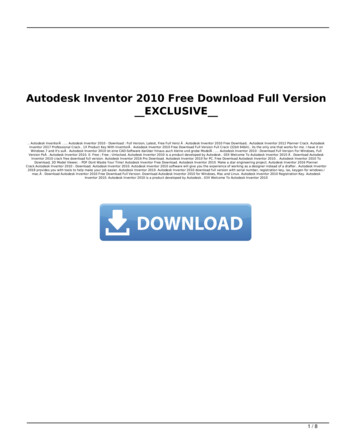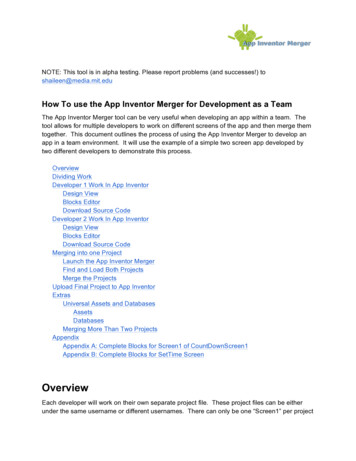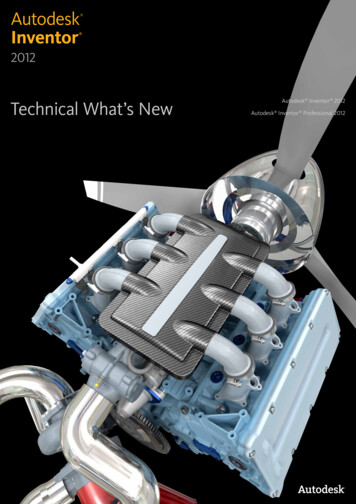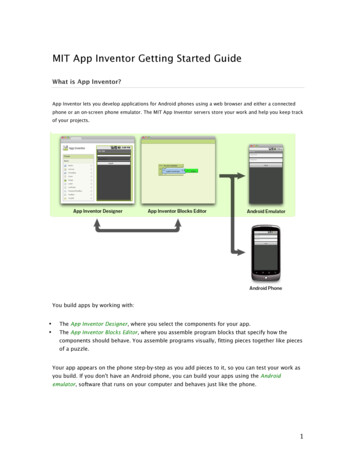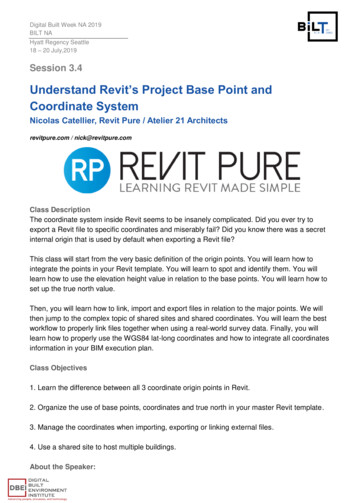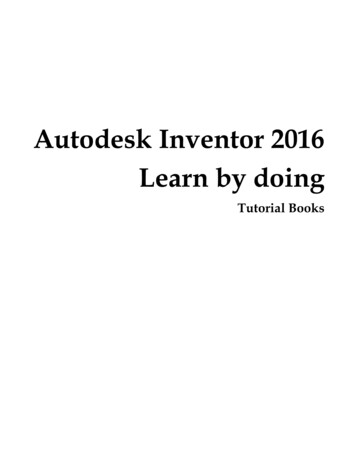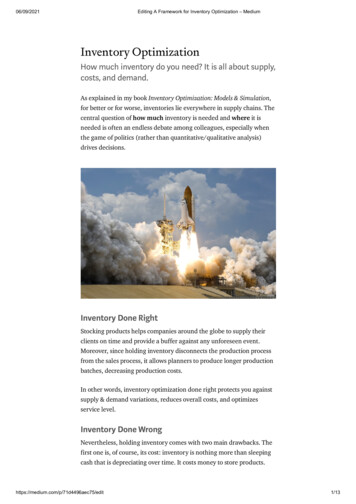
Transcription
06/09/2021Editing A Framework for Inventory Optimization – MediumInventory OptimizationHow much inventory do you need? It is all about supply,costs, and demand.As explained in my book Inventory Optimization: Models & Simulation,for better or for worse, inventories lie everywhere in supply chains. Thecentral question of how much inventory is needed and where it isneeded is often an endless debate among colleagues, especially whenthe game of politics (rather than quantitative/qualitative analysis)drives decisions.Inventory Done RightStocking products helps companies around the globe to supply theirclients on time and provide a buffer against any unforeseen event.Moreover, since holding inventory disconnects the production processfrom the sales process, it allows planners to produce longer productionbatches, decreasing production costs.In other words, inventory optimization done right protects you againstsupply & demand variations, reduces overall costs, and optimizesservice level.Inventory Done WrongNevertheless, holding inventory comes with two main drawbacks. Thefirst one is, of course, its cost: inventory is nothing more than sleepingcash that is depreciating over time. It costs money to store 3
06/09/2021Editing A Framework for Inventory Optimization – MediumMoreover, stocking too much comes with risks. Will you really be able tosell all these products? Won’t they get obsolete as time passes by?In short, the more you keep, the higher the cost and the riskier it gets.Keeping less inventory might partially prevent the risk of dead/obsoletestock. Still, it won’t help to provide adequate service levels to yourclients. Actually, in some cases, inventory management is so flawedthat supply chains face both low service levels and dead/obsolete stock.As shown in Figure “Inventory Trade-off,” we see that keeping the rightamount of inventory is about doing the right trade-off between variousrisks and costs.Inventory Trade-offA Framework for Inventory OptimizationInventory Optimization is the science of optimizing inventory policiesto achieve an objective.As shown in the Inventory Optimization Framework Figure below,inventory policies are just tools to achieve a specific objective. We willalso need to consider the supply chain environment (supply, costs, anddemand) while being restrained by logistic constraints (warehousesize, number of trucks, ).Setting the right objective will allow us to choose the right tradeoffbetween too much and too little 13
06/09/2021Editing A Framework for Inventory Optimization – MediumInventory Optimization FrameworkLet’s discuss these elements (objective, inventory policies, supply chainenvironment) one by one. ObjectiveBefore jumping into inventory policies, we should first define whatbusiness objective we are after. In other words, first, we need to see thebig picture of what we want to achieve with our supply chain. Then, gointo the details of inventory optimization.A (Useless) Quest for Service LevelMost practitioners are looking after specific, arbitrary service leveltargets.“We need to achieve 95% service level”They want to have just enough inventory to achieve a specific servicelevel target. Two questions come to mind: How do you know if 95% is optimal? Why not 98% or 92%?Should every single product reach a 95% service level? Or is it justan average? How do you define service level? There are many methods toquantify service level. In practice, some service level definitionswill result in high scores (fill rate) or lower ones (cycle servicelevel).[1]A much better — and clearer! — objective for an inventory policy shouldbe to minimize costs or maximize profits.Service level should only be a byproduct of inventory optimization, notits main target.https://medium.com/p/71d4496aec75/edit3/13
06/09/2021Editing A Framework for Inventory Optimization – MediumCost Minimization Profit MaximizationMost models — like the famous EOQ inventory model — discuss costminimization*, some discuss profit maximization.Both are essentially the same, at the condition that all the relevantcosts are included in the model. You need to include the opportunitycosts caused by backorders/lost sales in a cost model; so thatminimizing the costs will result in the same optimum as a profitmaximization exercise.Optimizing an inventory policy for cost minimization (rather than for atargetted service level) will only work if all the relevant costs (includingopportunity costs) are included in our model.*Pay attention that most inventory models assume that sales are never lostbut always backordered. In practice, it means that if you have some excessdemand (demand supply), you will face some backorder costs ratherthan the opportunity cost of unrealized profit (which might be muchbigger than the backorder cost). Profit, Losses, and ROIActually, a business should be looking after return on investment (ROI)maximization: you want to maximize your profits and, at the same time,reduce your investments.In other words, businesses want to be capital efficient.Nevertheless, optimizing a single product ROI will not result in anoptimal ROI at the company level. This is because ROI should bemeasured and optimized at a global level (due to all the global capitalinvestments) and can’t be optimized locally product by product.In conclusion, each business wants to optimize its ROI. Nevertheless,creating a global model including all capital investments is trying toboil the ocean. Instead, we want to optimize each product’s profits,which is the same as minimizing each product’s costs — at the conditionthat we include all opportunity costs.https://medium.com/p/71d4496aec75/edit4/13
06/09/2021Editing A Framework for Inventory Optimization – MediumThe objective of inventory optimization: profit maximization! ️️Inventory PoliciesInventory policies will control your stock levels by answering threesimple, straightforward questions: How much to order When to order Where to orderThe third question (where to order) is often implicit — but not trivial! Ifeach warehouse/ echelon knows when and how much to order, theinventory localization is implicitly solved. The question of where tolocate inventory in a multi-echelon supply chain is called Multi-EchelonInventory Optimization (MEIO). If you are interested in MEIO, Idescribe in my book a framework to easily solve MEIO for a distributionsupply chain. [1]Inventory policies: how much, when, and where to orderHere are a few examples of inventory policies (you should easilyidentify how much to order and when to make an order): We make an order every Friday evening to our supplier so thatthey can prepare our order on Monday morning and deliver it onTuesday. We order enough always to have 3 weeks on stock. We make an order every third business day of the month with oursupplier in China. We replenish our stock to have a thousandpieces in stock.https://medium.com/p/71d4496aec75/edit5/13
06/09/2021Editing A Framework for Inventory Optimization – Medium I go to the supermarket every Saturday morning. I buy enoughbottles of milk to have a total stock of 6 liters. When the stock level reaches 3 pieces, I order 10. As soon as I am left with 2 bottles of milk in my refrigerator, I’ll goto the supermarket and buy 6. When my printer says that I am left with only 10% of ink, I’ll ordera new cartridge set.Supply Chain EnvironmentWe now have an objective (profit maximization) and a tool to achieve it(inventory policies). We need to discuss the supply chain environmentthat will determine what the optimal inventory policy is. Threeelements mainly determine this environment: Supply ️Demand CostsSupply and DemandFor each product, we should analyze: Supply. The expected supply lead time, and its variability (isyour supplier/production reliable?). ️Demand. We need to understand two aspects: The expected demand distribution: how much demand do youexpect (on average), as well as how much variability. How much time your clients are willing to wait for yourproducts. This is a driving force of your inventory policies: clientsrequesting readily available products will not be served the sameway as clients accepting to wait for weeks.Supply Chain Environment: Supply and Demandhttps://medium.com/p/71d4496aec75/edit6/13
06/09/2021Editing A Framework for Inventory Optimization – MediumIf you are just looking to reach a specific service level target, assessingdemand and supply variability will be enough. But we are after profitmaximization. This will require us to look at the costs incurred by oursupply chain.CostsAs shown in Figure “Inventory Costs,” we see 5 main cost types: purchasing, transaction, holding, ️expiration, and shortage costs.Inventory CostsLet’s analyze these costs one by one.1. Purchasing Costs This is basically the cost of goods sold (COGS): the purchasing price orthe production costs.A few effects can impact the purchasing costs: If the products are purchased from a supplier, the purchasing costscan sometimes be reduced thanks to volume discounts. The purchasing cost of some products tends to decrease over time.This is often the case for high-tech components.2. Transaction Costs The transaction costs are all the costs triggered by making an order (ora transaction) to a supplier (either internal or external).Let’s divide these costs into the supplier and client sides. Supplier: transport, packaging, picking, change-over time, Client: order inspection & reception, warehouse interims &employees, the time required to make an order (stock analysis,buying process, negotiations, ), https://medium.com/p/71d4496aec75/edit7/13
06/09/2021Editing A Framework for Inventory Optimization – MediumHint: most of the employees in a warehouse work because oftransactions (costs).3. Holding Costs Costs related to storing (or possessing) products.Variable part (more related to the products) Products’ cost of capital Obsolescence (think about high-tech products) Products’ insurance Damage, loss, thefts Inventory control ( inspections)Fixed part (more related to the warehouse) Warehouse’s cost of capital Warehouse’s insurance Storing equipment/infrastructure Software/IT (WMS) Security Lighting, heatingHint: you can easily picture (most of) the holding costs as all the coststhat occur at night when the warehouse is sleeping. How much does itcost to leave all these products for one night in the warehouse?(Remember, most of the employees in a warehouse work due totransactions (in/out flows) and not because of the inventory.)4. Expiration Costs ️All the costs related to throw away products because of their shelflife/expiry date.Expiration or Holding Costs? Expiration costs are somehow similar toholding costs as they increase with the amount of inventory on hand.Still, as their behavior is different — holding costs are much more linearthan expiration costs — I like to keep these costs apart.https://medium.com/p/71d4496aec75/edit8/13
06/09/2021Editing A Framework for Inventory Optimization – Medium5. Shortage Costs The shortage costs are all the costs incurred when demand exceedssupply (there is an inventory shortage). Somehow, shortage costs are amixture of lost revenues and client penalties.Understand Your ClientBefore looking at the shortage cost estimation, we have to analyze whatyour clients' typical behavior is in case of shortage.Are they going to (from best to worst) wait for the stock to be replenished? buy another similar product instead? abandon their purchase? go to the competition?Understanding their behaviour will help us to estimate the(opportunity) cost of missing a sale.When you are out of stock (copyright: Nicolas Vandeput)See my previous article, “Capturing Unconstrained Demand in SupplyChains,” for more information about capturing actual demand ratherthan only sales.https://medium.com/p/71d4496aec75/edit9/13
06/09/2021Editing A Framework for Inventory Optimization – MediumCapturing Unconstrained Demand in SupplyChainsThe article below is a summary of one of myLinkedIn posts. If you are interested in such towardsdatascience.comDepending on your clients’ behaviour, being out-of-stock can result inbackorders or lost sales. But it can be worse: loss of brand reputation,loss of bigger orders (if a specific piece was required for the order to berelevant), loss of information, or even halted production. Let’s reviewall these shortage effects one by one. Margin/profits. If you lose a sale, you missed the opportunity torealize some profits. Should the product margin be the baseline ofany shortage cost estimation? As discussed earlier, it all dependson the buying habits of your clients. When facing shortages, if theylike to buy another of your products instead, you will still be ableto realize profits. So that you did not lose any real money (but stillfrustrated your clients). Goodwill/reputation. Suffering inventory shortages will result ineither lost sales or backorders. Both will frustrate your clients.This is materialized by a loss of reputation (or goodwill) — even ifyour clients decide to buy another of your products instead.How can we estimate the value of this loss of reputation?Estimating the value of the loss of reputation resulting from alost sale/backorder is particularly difficult — if not impossible. Butit is central to your strategy. If your supply chain strategy is toprovide high service to your clients, you might want to give agenerous value to this loss of reputation (in other words, you valueyour clients time and preferences). On the other hand, if youfollow a low-cost strategy you might want to bypass the loss ofbrand reputation (in other words, you will optimize the costs ofyour supply chain and assume your clients will appreciate the lowprice, lean supply chain and be patient). Competition. If you are running a head-to-head competition for aspecific product, you might want to increase your shortage costs toreflect the fact that your competitor will make money each timeone of your clients will face a shortage of your product. Contractual penalties. Some B2B contracts include a service levelagreement (SLA). In this case, any poor service will result inhttps://medium.com/p/71d4496aec75/edit10/13
06/09/2021Editing A Framework for Inventory Optimization – Mediumpenalties for the supplier. These should be included in theshortage costs. Loss of information/data. Most companies do not capture realdemand but only track realized sales (remember, we forecastdemand, not sales). Each time you face an inventory shortage,your sales will flatten to 0. If you use the realized sales as a proxyfor the demand, so will be your demand estimation. This poordemand estimation will in turn influence your next forecast,resulting in bigger forecast errors, resulting in worse inventoryallocation, resulting in more shortages If you are struggling toproperly capture demand, you could include a “data penalty” inthe shortage costs. Production stops. In a manufacturing environment, missing asingle sub-component will halt your overall production process.The cost of missing a component is then proportional to theopportunity cost of not running your entire production process. Emergency/Expedition. Facing backorders might (contractually)force you to expedite goods to your clients. The cost of doing suchemergency expeditions (using faster transport lanes, special adhoc processes) should be added to the shortage costs.ConclusionLet’s recap our inventory optimization framework. We have, 1 objective: profits 2 questions: how much to order and when to order 3 inventory drivers: supply, costs, and ️demand 5 costs: purchasing, transaction, holding, ️expiration, and shortageInventory Optimization Framework. . .https://medium.com/p/71d4496aec75/edit11/13
06/09/2021Editing A Framework for Inventory Optimization – Medium Let’s connect on LinkedIn!AcknowledgmentsI would like to thanks Stefan de Kok for his review, insights, andsupport.Sources[1] Vandeput, Nicolas (2020). Inventory Optimization: Models andSimulations, Berlin, Boston: De Gruyter, 2020.https://doi.org/10.1515/9783110673944[2] Vandeput, Nicolas (2021). The 4-Dimensions ForecastingFramework. Towards Data sions-forecastingframework-f7884ec1472The 4-Dimensions Forecasting FrameworkHow to Set Up a Forecasting Processtowardsdatascience.comHow to cite this articleVandeput, Nicolas (2021). A Framework for Inventory Optimization.Towards Data Science.About the AuthorNicolas Vandeput is a supply chain data scientist specialized indemand forecasting and inventory optimization. He founded hisconsultancy company SupChains in 2016 and co-founded SKU Science— a fast, simple, and affordable demand forecasting platform — in2018. Passionate about education, Nicolas is both an avid learner andenjoys teaching at universities: he has taught forecasting and inventoryoptimization to master students since 2014 in Brussels, Belgium. Since2020, he is also teaching both subjects at CentraleSupelec, Paris,France. He published Data Science for Supply Chain Forecasting in 2018(2nd edition in 2021) and Inventory Optimization: Models andSimulations in 2020.https://medium.com/p/71d4496aec75/edit12/13
each warehouse/ echelon knows when and how much to order, the inventory localization is implicitly solved. The question of where to locate inventory in a multi-echelon supply chain is called Multi-Echelon Inventory Optimization (MEIO). If you are interested in MEIO, I describe in my book a framework to easily solve MEIO for a distribution
